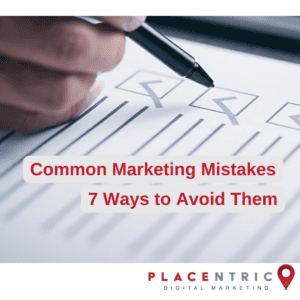
My most recent work has involved the audit of the digital marketing activities of hundreds of businesses. There were several issues that I saw over and over. Some common technical issues needed the attention of a skilled developer, but many issues were due to the lack of a strategic marketing plan. From this experience, I’ve created this list of common marketing mistakes to avoid:
- Failure to understand the target audience.
- Insufficient allocation of resources (budget, time, people).
- A disconnect between marketing staff and others in the organization.
- Allocation of marketing to junior staff or interns without proper guidance.
- Outdated information, images, etc.
- Using paid advertising (Google Ads, etc.) instead of keeping your own channels up to date and optimized.
- Outsource work to those who don’t have the correct skills, don’t understand your needs, are not responsive, or just do a poor job. I was horrified when one person I worked with seemed afraid to give my suggestions to her web developer because he was so difficult to deal with. I saw that a lot in the early days of digital marketing and am surprised it still happens fairly often.
What was most surprising? Many business owners didn’t realize they were making any mistakes or losing out on sales because of them.
7 Ways to Avoid Common Marketing Mistakes
- Target Market Research is the necessary base of any marketing plan. You need to know about your audience, their needs relevant to what you offer and how to reach and engage them effectively. A lack of this knowledge leads to wasted time and money putting out a message that is not effective.
- Give marketing sufficient priority and resources and communicate this throughout the organization. While interactions with existing customers and revenue-generating activities must have the highest priority, you cannot expect great results from your marketing without sufficient planning and time to carry out full campaigns. See more on planning below.
- Also, ensure that the marketing team has access to key personnel and that information is given and received, so the organization acts in unison.
- Allocate sufficient funds for the areas of marketing that need it most to ensure professionalism and consistency:
- Branding and Design. Use a professional designer to develop your brand and guidelines to be followed by those who create anything that represents your organization. Have a professional designer create templates for your website and social media posts.
- Software/Apps, from the platform for your website to those to create and schedule social media posts.
- Training and guidance of internal staff. Weigh up the cost and time for training your own staff against the cost of outsourcing. You can save money using interns for social media and basic website edits, but they will need proper guidance.
- Outsource work that your internal staff doesn’t have the skill or time to carry out effectively.
- Create guidelines for marketing activities that align with the organization’s overall goals and ethos and your overall marketing and business plans. This ensures that all staff are “on the same page” and makes onboarding easier. If you are outsourcing work, this is necessary information for that team.
- Plan and create content well in advance with time allocated specifically for this. Very often, websites get out of date, and social media posts are hit and miss because staff didn’t get around to doing the work because “things got in the way.” Sufficient time to plan and create means you are putting out a well-thought-out, professional message consistently.
- Use paid advertising only for well-developed, specific, targeted campaigns and not because you don’t have the time or skill to do organic marketing effectively.
- When you outsource work, agree on terms regarding responsiveness, time frames, quality of work, etc., and ensure that their staff is sufficiently skilled, understands your business’s needs, and treats your staff respectfully.
Most medium and large-sized businesses will have a business plan that includes some marketing activities but not a detailed marketing plan. Many smaller businesses have no plan. Some would say that’s a plan for failure. Avoid making common marketing mistakes by developing a strategic marketing plan that ensures all marketing aspects are carried out professionally, consistently, and sufficiently funded within your organization’s overall budget.
What if you are working solo? Many of these issues are still relevant to your business and, in some cases, even more so. You are more likely to be distracted from marketing by day-to-day operations and less likely to allocate sufficient funds for professional campaigns. In many cases, investment in a well-developed strategic marketing plan will increase business and profits.
Click here to schedule a call with me about how to avoid these common marketing mistakes.


